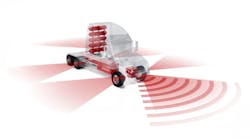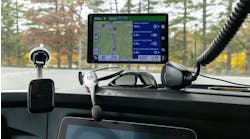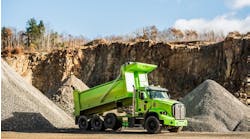Trucking remains at a crossroads when it comes to figuring out the right balance of technologies for different applications and use cases. Whether switching to battery-electric powertrains or hydrogen internal combustion engines from conventional diesel or implementing connected vehicle technologies, advanced driver assistance systems (ADAS), and even Level 4 automation, successful adoption of anything new takes a lot of testing, vetting, and end-user buy-in.
More and more over the last few years, seemingly unlikely partnerships and new market entrants are moving rapidly to meet some of the demands of these newer technologies. One global engineering provider, FEV, laid its foundation in developing vehicle and powertrain strategies in the automotive sector for more than 40 years. The company has recently branched into the commercial vehicle space, developing full, turnkey truck designs and transitional solutions for North American OEMs.
FEV recently partnered with electrified powertrain systems startup Hyliion to support the design, development, integration, and validation of Hyliion’s Hypertruck Electric Range Extender (ERX) for Class 8 tractor-trailer applications. Through that partnership, FEV is also developing the controls strategy for the propulsion system and providing vehicle integration for OEM ADAS features, controls, and driver interfaces.
“FEV can design and develop a full truck like an OEM,” explained Tom Tasky, vice president at FEV. “We are doing that today for full turnkey applications for some customers when they need it, or bits and pieces, meaning if they only want us to do the cab design, we can do that. We’ll do electrification, fuel cell, hydrogen technologies, conventional diesel powertrains, etc. Commercial vehicle is the biggest part of our business these days.”
To better understand how companies like FEV work directly with truck OEMs to advance some of these newer technologies, FleetOwner sat down with Tasky, who leads FEV’s mobility and software development for connected and automated mobility solutions, systems engineering, and software solutions. Tasky discussed how future software-defined vehicles (SDV) would benefit fleets and drivers, clean-sheet truck and powertrain designs for OEMs, and FEV’s approach to safety and cybersecurity efforts in commercial vehicle development.
[Editor’s note: The following conversation has been edited for brevity and clarity.]
FleetOwner: How is FEV working with commercial truck OEMs to integrate ADAS features, controls, and driver interfaces for connected vehicles?
Tom Tasky: We work as an extension of the OEM customer. We might have a small team on-site at the OEM, but then we will adopt their tools and processes or provide our own and really be an extension of their team. For ADAS, we work with their existing supplier, so we’ll do the specification for them, interfaces, understanding the networking and communications, specify the test cases, run simulation, and then execute testing.
FO: When it comes to safety and security in commercial vehicle development, what should be the approach?
TT: There has been rapid expansion in the commercial truck space over the past few years.
We are helping a lot of OEMs with the research and development side to meet these safety standards. That could start at the vehicle level to say, ‘Here are the potential risks for safety and security vulnerabilities.’ From there, you can communicate those risks and safety requirements down to the suppliers.
These big challenges require a lot of extra effort on the trucking side. Some of the cybersecurity vulnerabilities when introducing things like over-the-air updates are: Is the vehicle secure? Is the data secure? Is privacy maintained?
FO: Is there anything the end user really needs to know to keep these systems secure?
TT: Any opportunity to plug into the truck and any kind of system as new technologies are being introduced or aftermarket products or telematics devices are being deployed has potential vulnerabilities. For cybersecurity purposes, you can gain access through the CAN, messaging network, or through a Wi-Fi or cellular Bluetooth interface. Are those interfaces secure? What data could be compromised?
If software is being updated and altered, you could potentially run into emissions certification violations. It’s a very rare occurrence, but the ultimate threat is manipulated data from the controller.
Generally, we are talking about newer developments, but for trucks that have been on the road for many years, as well as aftermarket products, really need to be looked at to ensure that systems are safe. We want to make sure that someone can’t come in with a rogue device plug-in and hack a system.
FO: Let’s discuss the software-defined vehicle, the role software has in the development of commercial vehicles, and FEV’s role in SDV development.
TT: This was a hot topic at CES. We saw the software-defined vehicle everywhere. This is the iPhone on wheels. It’s going to take a while for it to be deployed, but everything is software-developed these days.
A software-defined vehicle is basically: How do you customize the product? How do you further allow creativity of software features to be developed? For that, you need to understand how to get that software enabled, which requires changes to the electrical architecture. The whole architecture of the system needs to be redesigned, and that’s a major undertaking, which is being discussed and planned to be rolled out in the coming years with most OEMs.
Then, how do you maintain existing fleets and new technology? It’s going to take years for this to be fully deployed, but it’s coming. It will allow the fleet operators to think of customization of software and to think about everything they are doing with aftermarket features today that would potentially allow these features to be integrated with the OEM stock truck. It will open up the capabilities and possibilities when you look at the speed of fixing a potential issue, collecting new data, updating features to the benefit of the operator, and making the truck more efficient.
FO: How will fleets benefit in the long run?
TT: A lot of [these technologies] exist today, but it will happen more in real-time. So, if you have a performance issue, maintenance issue, or a potential failure, it could be detected. I think we’ve gotten better as far as identifying potential failures early on with vehicle prognostics and health management, but now you could go even further and optimize when components are replaced or make a software change to extend vehicle life or fix an issue.
I think we will see more efficiency and gains on products to eliminate downtime, to further keep emissions in check, and preconditioning the cab for driver comfort. Custom features can be managed so if a different driver uses a truck, you can configure the settings before the driver gets to the truck. Driver comfort could be a big enhancement that can be implemented easily through this process.
FO: What are some of the challenges, or learning curves, that fleets will have to overcome when it comes to adopting newer technologies?
TT: A lot of it is education—just like with ADAS—trusting the system, understanding the complexity, and proving that it is a benefit. These are all required to ensure the successful rollouts of these technologies.
I think the benefits to the fleet operators will be enormous due to more accurate data and the ability to control and change features.
Fleet operators need to provide input for what they desire from the OEM. That’s an exciting process for them to get engaged and say, ‘Hey, we could really use this.’
The full rollout of software-designed architecture is still five to 10 years before we see large numbers of vehicles out on the road with this capability. Some OEMs might want to deploy quicker, and you could probably do smaller subsets of the systems’ architecture to gain the benefits.
I think all applications could benefit from SDVs over time. No matter the use case and duty cycle, there will be benefits for collecting the data, optimizing routes, driver monitoring, and for driver comfort. All these benefits will drive the technology and adoption.




